Herbicides are the most efficient and cost-effective way to control grass weeds. Their use will remain vital to crop production alongside cultural/non-chemical integrated weed management tools.
These actions are also necessary because grass weeds develop resistance to key ACCase (eg Axial, Falcon, Stratos Ultra) and ALS (eg Pacifica Plus, Broadway Star) modes of action.
Grass weed herbicide resistance is mainly influenced by the following factors:
Selection intensity: herbicide dose (using rates lower than full recommended field rates), frequency (using herbicides from the same mode of action for two or more consecutive years) and timing of application (spraying older or larger plants) all increase population size and place pressure on herbicides.Frequency of resistance present in populations: a small number of resistant individuals exist naturally within populations even before herbicide use. When a herbicide is applied, these individuals survive and set seed, while most susceptible plants die. Repeated use of the same herbicide eventually results in larger population of resistant survivors in that field.The biology: outcrossing species (eg blackgrass, Italian ryegrass) with high seedbank populations and short soil seedbank life are likely to develop resistance rapidly.Weed pressure: the greater the population size, the greater the likelihood of any herbicide selecting resistant individuals within that population.In this article, I summarise the results of the efficacy of ACCase, ALS and glyphosate herbicides to assist an integrated weed management and resistance management plan tailored for targeted grass weeds and individual growers. The increasing populations of difficult-to-control grass weeds in tillage fields make this information critical.
Spring wild oats and sterile brome
These are the most widespread and competitive species in cereal crops.
With over 100 field populations of wild oats screened to date, ACCase resistance or cross-resistance has been detected in 15% of populations.
But there was no evidence of poor control from ALS herbicides at both rates (Figure 1) when used at correct plant growth (three- to four-leaf) stage.

Figure 1: Control levels of populations of wild oats following ACCase/ALS herbicide treatments applied at full and half recommended field rates.
Of the more than 100 field populations of brome tested, there were only a few populations with full ALS-resistance. But there is widespread tolerance to ALS-Pacifica and/or ACCase-Stratos Ultra at half rate, which may be a consequence of the frequent use of reduced field rates (Figure 2).
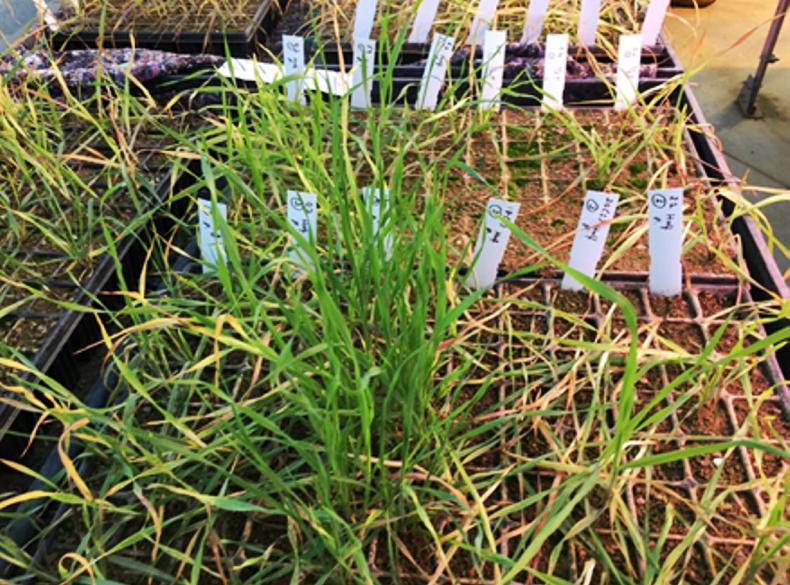
Figure 2: Brome individuals within a population surviving after 35 days of ALS-Pacifica treatment at half rate.
Remember, Axial does not offer brome control so there are no effective chemical options in winter barley. For this reason, it is necessary to use at least 1.5l/ha of glyphosate before sowing to reduce population size.
Additionally, ALS-Broadway Star and ACCase-Falcon were highly active on all populations at half or full rate when used at correct plant growth (two- to three-leaf) stage. This makes these actives important tools in eliminating less-sensitive bromes within crops.
As a rule, unless a field has a small population with high herbicide susceptibility, it is always recommended to use full rate of effective herbicides to control self-pollinating wild oats and bromes.
Growers are facing a significant challenge when managing blackgrass. Nearly 50% of field populations tested to date were multiple-resistant, showing resistance to ACCase-Falcon and/or Stratos Ultra, as well as to ALS-Pacifica or Monolith (Figure 3).
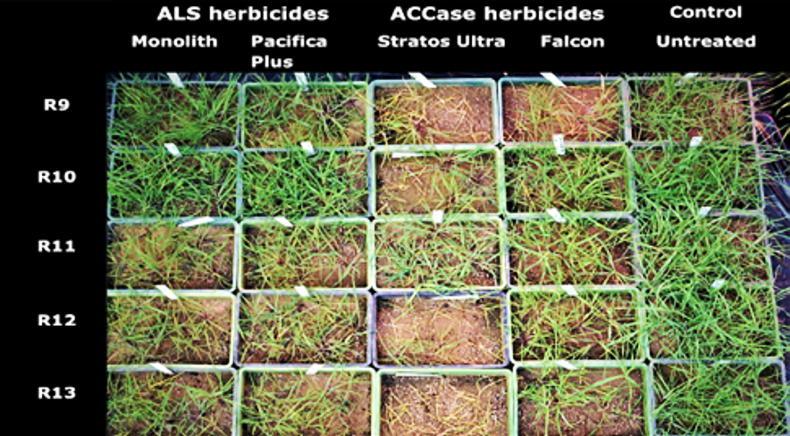
Figure 3: Control levels of blackgrass populations after ACCase/ALS herbicide treatments applied at full recommended field rates.
But ACCase-Centurion Max was found to offer above 90% control of resistant populations (Figure 4), when used at correct plant growth (two- to three-leaf) stage, making it an important tool to eliminate resistant blackgrass in non-cereal break crops (eg winter oilseed rape).

Figure 4: Symptoms of blackgrass populations following application of ACCase-Centurion Max at dose rates ranging from 0.25 to 2 times the full recommended field rate (highlighted in red).
Full recommended field rate
As a rule, full recommended field rate of effective herbicides must always be used to control outcrossing blackgrass populations (whether sensitive or resistant).
In addition, at least 3.0 l/ha of glyphosate was necessary to effectively control both sensitive and resistant blackgrass (Figure 5).
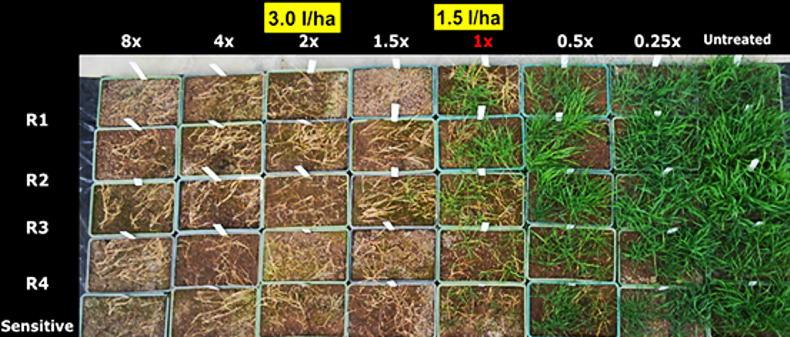
Figure 5: Symptoms of blackgrass populations following application of glyphosate at dose rates ranging from 0.25 to 8 times the full recommended field rate (highlighted in red).
Despite the fact that Italian ryegrass is only present on a small number of tillage farms, nearly 60% of populations tested had cross-resistance to all ALS herbicides, and a few of these populations also carried resistance to ACCase herbicides (Figure 6).
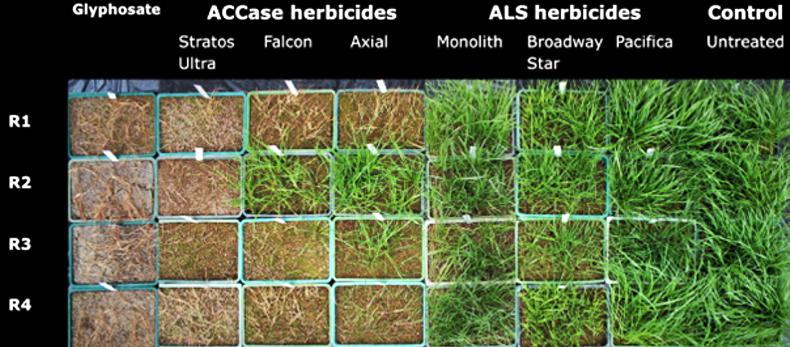
Figure 6: Control levels of Italian ryegrass populations after ACCase, ALS and glyphosate herbicide treatments applied at full recommended field rates.
But ACCase-Stratos Ultra or Centurion Max at full rate, and glyphosate using at least 1.5 l/ha, were highly effective in eliminating resistant populations when used at correct plant growth (two- to three-leaf) stage.
As a rule, the full recommended field rate of effective herbicides must always be used to control outcrossing Italian ryegrass populations (whether sensitive or resistant).
We primarily rely on several pre-emergent herbicides (eg pendimethalin, flufenacet, prosulfocarb, etc.) to control annual meadow grass but our research found the first case of cross-resistance to ALS herbicide (Pacifica and Broadway Star) types in Ireland (Figure 7).
This is the second case of resistance in tillage situations in Europe (the first one being in France), so increased vigilance in identifying and mitigating resistant populations is essential. But ACCase-Centurion Max at full rate and glyphosate (at least 1.5l/ha) provided over 95% control, when used at correct plant growth (two- to three-leaf) stage (Figure 7).
Annual meadow-grass appears naturally tolerant to the most commonly used ACCase herbicide (eg Axial, Falcon) types.

Figure 7: Symptoms of annual meadow-grass following application of ACCase (Axial, Falcon, Centurion Max) and ALS (Pacifica, Broadway) herbicides at dose rates ranging from 0.25 to 8 times full recommended rates (highlighted in red). Also shows is the control using glyphosate at dose rates between 0.15 and two times full recommended rate.
This is a relatively new grass weed in Ireland and not usually listed on chemical labels. Initial screening indicates that this weed is naturally tolerant to ACCase herbicides (Figure 8). But ALS-Pacifica and Broadway Star and glyphosate were highly effective, when used at correct plant growth (two- to three-leaf) stage.
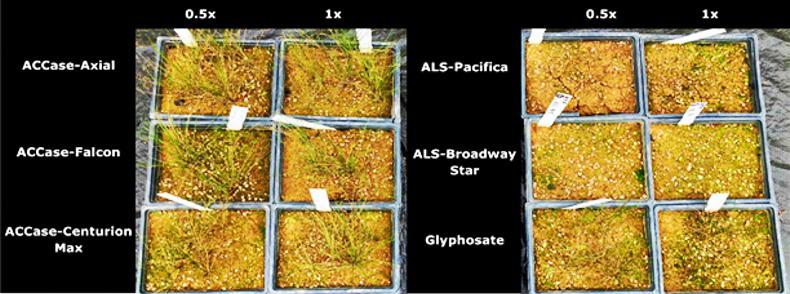
Figure 8: Control levels of rat’s tail fescue after ACCase, ALS and glyphosate herbicide treatments applied at half and full recommended rates.
It is recommended to use ALS herbicides at full rate, and glyphosate at least 3.0 l/ha for maximum efficacy and for preserving existing chemical options.
This weed is not listed on chemical labels (ACCase-Foxtrot offers control of awned canary grass).
Initial screening found that ACCase, ALS and glyphosate herbicides effectively controlled populations but only when applied at full rate (Figure 9).
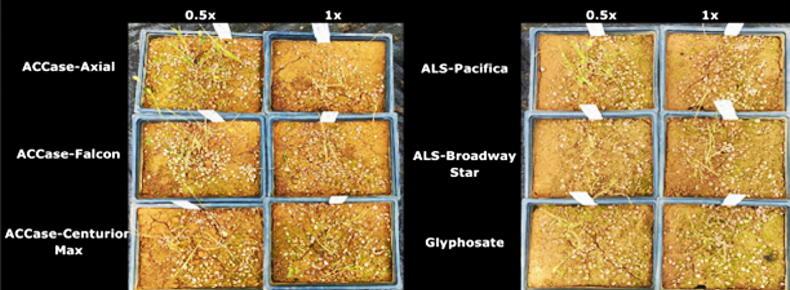
Figure 9: Control levels of lesser canary grass after ACCase, ALS and glyphosate herbicide treatments applied at half and full recommended rates.
Rough-stalked meadow grass
In addition to pre-emergent herbicide options (eg pendimethalin, flufenacet and prosulfocarb), initial screening found that all ACCase, ALS and glyphosate herbicides gave total control, specifically at full rates.
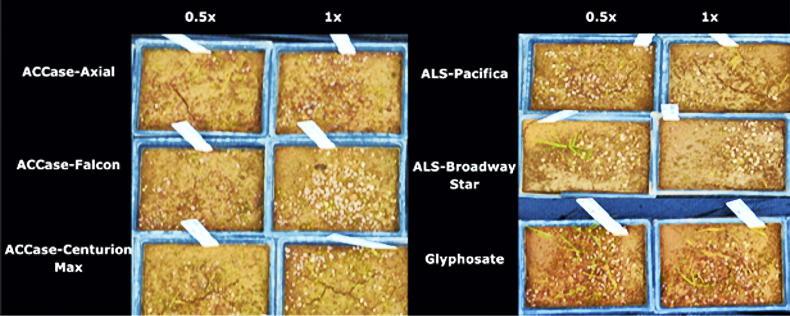
Figure 10: Control levels of rough-stalk meadow grass after ACCase, ALS and glyphosate herbicide treatments applied at half and full recommended field rates.
Overall, herbicide cross- and multiple-resistance has severely limited our ability to effectively control critical grass weeds.
Remember, these results were obtained under ‘optimal conditions’ in a controlled glasshouse rather than in the field, which could further affect product efficacy.
An integrated weed management approach will help preserve existing chemicals that are still effective (see Table 1). Some of the key strategies include:
Keep accurate records of weed populations present in fields, their location(s) and the herbicides applied on a field basis.
Use robust full recommended field rates to ensure maximum efficacy.
Use glyphosate before crop sowing followed by residual herbicides (eg pendimethalin, flufenacet and prosulfocarb) to reduce target population size.
Always apply ACCase/ALS herbicides on small and actively growing plants.Especially for blackgrass and Italian ryegrass – avoid using ACCase or ALS herbicides as the only control option in the same field in consecutive years.If resistance is suspected (especially in fields with a long history of continuous herbicide use) do not use the same herbicide or herbicide from the same mode of action.Conduct resistance testing to establish the sensitivity status of your population and the effective control options that are available.
Ensure surviving plants do not set and shed viable seeds to the soil seedbank by either using alternative herbicides, spot spraying or hand rogueing.Always use chemical control jointly with cultural/non-chemical control options (eg crop rotation, stale seedbed technique, manipulating sowing time) and on-farm biosecurity measures (eg use of certified seed, machinery hygiene, etc) to help give effective herbicides every chance to achieve maximum efficacy and control over time. Resistance has significantly reduced our chemical options for controlling grass weeds.For farms with blackgrass and Italian ryegrass, the resistance status must be determined before sowing to identify effective chemical control options.Rotational crops are critical for grass weed control (resistant or less-sensitive).It is essential to protect the declining number of existing effective chemistries by implementing integrated weed management tools.
Herbicides are the most efficient and cost-effective way to control grass weeds. Their use will remain vital to crop production alongside cultural/non-chemical integrated weed management tools.
These actions are also necessary because grass weeds develop resistance to key ACCase (eg Axial, Falcon, Stratos Ultra) and ALS (eg Pacifica Plus, Broadway Star) modes of action.
Grass weed herbicide resistance is mainly influenced by the following factors:
Selection intensity: herbicide dose (using rates lower than full recommended field rates), frequency (using herbicides from the same mode of action for two or more consecutive years) and timing of application (spraying older or larger plants) all increase population size and place pressure on herbicides.Frequency of resistance present in populations: a small number of resistant individuals exist naturally within populations even before herbicide use. When a herbicide is applied, these individuals survive and set seed, while most susceptible plants die. Repeated use of the same herbicide eventually results in larger population of resistant survivors in that field.The biology: outcrossing species (eg blackgrass, Italian ryegrass) with high seedbank populations and short soil seedbank life are likely to develop resistance rapidly.Weed pressure: the greater the population size, the greater the likelihood of any herbicide selecting resistant individuals within that population.In this article, I summarise the results of the efficacy of ACCase, ALS and glyphosate herbicides to assist an integrated weed management and resistance management plan tailored for targeted grass weeds and individual growers. The increasing populations of difficult-to-control grass weeds in tillage fields make this information critical.
Spring wild oats and sterile brome
These are the most widespread and competitive species in cereal crops.
With over 100 field populations of wild oats screened to date, ACCase resistance or cross-resistance has been detected in 15% of populations.
But there was no evidence of poor control from ALS herbicides at both rates (Figure 1) when used at correct plant growth (three- to four-leaf) stage.

Figure 1: Control levels of populations of wild oats following ACCase/ALS herbicide treatments applied at full and half recommended field rates.
Of the more than 100 field populations of brome tested, there were only a few populations with full ALS-resistance. But there is widespread tolerance to ALS-Pacifica and/or ACCase-Stratos Ultra at half rate, which may be a consequence of the frequent use of reduced field rates (Figure 2).

Figure 2: Brome individuals within a population surviving after 35 days of ALS-Pacifica treatment at half rate.
Remember, Axial does not offer brome control so there are no effective chemical options in winter barley. For this reason, it is necessary to use at least 1.5l/ha of glyphosate before sowing to reduce population size.
Additionally, ALS-Broadway Star and ACCase-Falcon were highly active on all populations at half or full rate when used at correct plant growth (two- to three-leaf) stage. This makes these actives important tools in eliminating less-sensitive bromes within crops.
As a rule, unless a field has a small population with high herbicide susceptibility, it is always recommended to use full rate of effective herbicides to control self-pollinating wild oats and bromes.
Growers are facing a significant challenge when managing blackgrass. Nearly 50% of field populations tested to date were multiple-resistant, showing resistance to ACCase-Falcon and/or Stratos Ultra, as well as to ALS-Pacifica or Monolith (Figure 3).

Figure 3: Control levels of blackgrass populations after ACCase/ALS herbicide treatments applied at full recommended field rates.
But ACCase-Centurion Max was found to offer above 90% control of resistant populations (Figure 4), when used at correct plant growth (two- to three-leaf) stage, making it an important tool to eliminate resistant blackgrass in non-cereal break crops (eg winter oilseed rape).

Figure 4: Symptoms of blackgrass populations following application of ACCase-Centurion Max at dose rates ranging from 0.25 to 2 times the full recommended field rate (highlighted in red).
Full recommended field rate
As a rule, full recommended field rate of effective herbicides must always be used to control outcrossing blackgrass populations (whether sensitive or resistant).
In addition, at least 3.0 l/ha of glyphosate was necessary to effectively control both sensitive and resistant blackgrass (Figure 5).

Figure 5: Symptoms of blackgrass populations following application of glyphosate at dose rates ranging from 0.25 to 8 times the full recommended field rate (highlighted in red).
Despite the fact that Italian ryegrass is only present on a small number of tillage farms, nearly 60% of populations tested had cross-resistance to all ALS herbicides, and a few of these populations also carried resistance to ACCase herbicides (Figure 6).

Figure 6: Control levels of Italian ryegrass populations after ACCase, ALS and glyphosate herbicide treatments applied at full recommended field rates.
But ACCase-Stratos Ultra or Centurion Max at full rate, and glyphosate using at least 1.5 l/ha, were highly effective in eliminating resistant populations when used at correct plant growth (two- to three-leaf) stage.
As a rule, the full recommended field rate of effective herbicides must always be used to control outcrossing Italian ryegrass populations (whether sensitive or resistant).
We primarily rely on several pre-emergent herbicides (eg pendimethalin, flufenacet, prosulfocarb, etc.) to control annual meadow grass but our research found the first case of cross-resistance to ALS herbicide (Pacifica and Broadway Star) types in Ireland (Figure 7).
This is the second case of resistance in tillage situations in Europe (the first one being in France), so increased vigilance in identifying and mitigating resistant populations is essential. But ACCase-Centurion Max at full rate and glyphosate (at least 1.5l/ha) provided over 95% control, when used at correct plant growth (two- to three-leaf) stage (Figure 7).
Annual meadow-grass appears naturally tolerant to the most commonly used ACCase herbicide (eg Axial, Falcon) types.

Figure 7: Symptoms of annual meadow-grass following application of ACCase (Axial, Falcon, Centurion Max) and ALS (Pacifica, Broadway) herbicides at dose rates ranging from 0.25 to 8 times full recommended rates (highlighted in red). Also shows is the control using glyphosate at dose rates between 0.15 and two times full recommended rate.
This is a relatively new grass weed in Ireland and not usually listed on chemical labels. Initial screening indicates that this weed is naturally tolerant to ACCase herbicides (Figure 8). But ALS-Pacifica and Broadway Star and glyphosate were highly effective, when used at correct plant growth (two- to three-leaf) stage.

Figure 8: Control levels of rat’s tail fescue after ACCase, ALS and glyphosate herbicide treatments applied at half and full recommended rates.
It is recommended to use ALS herbicides at full rate, and glyphosate at least 3.0 l/ha for maximum efficacy and for preserving existing chemical options.
This weed is not listed on chemical labels (ACCase-Foxtrot offers control of awned canary grass).
Initial screening found that ACCase, ALS and glyphosate herbicides effectively controlled populations but only when applied at full rate (Figure 9).

Figure 9: Control levels of lesser canary grass after ACCase, ALS and glyphosate herbicide treatments applied at half and full recommended rates.
Rough-stalked meadow grass
In addition to pre-emergent herbicide options (eg pendimethalin, flufenacet and prosulfocarb), initial screening found that all ACCase, ALS and glyphosate herbicides gave total control, specifically at full rates.

Figure 10: Control levels of rough-stalk meadow grass after ACCase, ALS and glyphosate herbicide treatments applied at half and full recommended field rates.
Overall, herbicide cross- and multiple-resistance has severely limited our ability to effectively control critical grass weeds.
Remember, these results were obtained under ‘optimal conditions’ in a controlled glasshouse rather than in the field, which could further affect product efficacy.
An integrated weed management approach will help preserve existing chemicals that are still effective (see Table 1). Some of the key strategies include:
Keep accurate records of weed populations present in fields, their location(s) and the herbicides applied on a field basis.
Use robust full recommended field rates to ensure maximum efficacy.
Use glyphosate before crop sowing followed by residual herbicides (eg pendimethalin, flufenacet and prosulfocarb) to reduce target population size.
Always apply ACCase/ALS herbicides on small and actively growing plants.Especially for blackgrass and Italian ryegrass – avoid using ACCase or ALS herbicides as the only control option in the same field in consecutive years.If resistance is suspected (especially in fields with a long history of continuous herbicide use) do not use the same herbicide or herbicide from the same mode of action.Conduct resistance testing to establish the sensitivity status of your population and the effective control options that are available.
Ensure surviving plants do not set and shed viable seeds to the soil seedbank by either using alternative herbicides, spot spraying or hand rogueing.Always use chemical control jointly with cultural/non-chemical control options (eg crop rotation, stale seedbed technique, manipulating sowing time) and on-farm biosecurity measures (eg use of certified seed, machinery hygiene, etc) to help give effective herbicides every chance to achieve maximum efficacy and control over time. Resistance has significantly reduced our chemical options for controlling grass weeds.For farms with blackgrass and Italian ryegrass, the resistance status must be determined before sowing to identify effective chemical control options.Rotational crops are critical for grass weed control (resistant or less-sensitive).It is essential to protect the declining number of existing effective chemistries by implementing integrated weed management tools. 














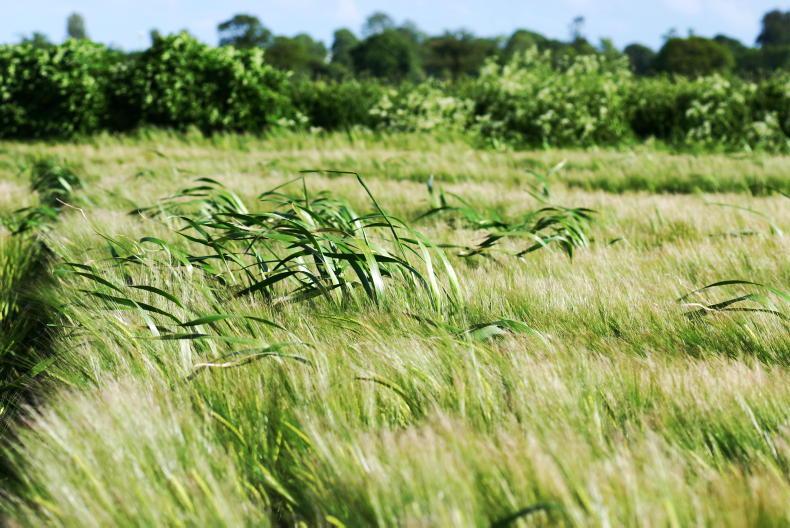


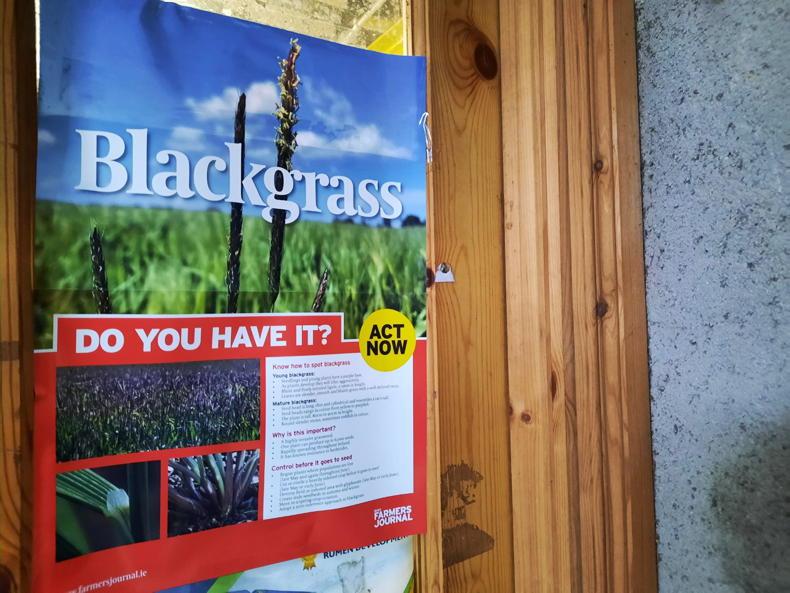
SHARING OPTIONS